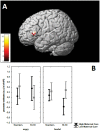DAT by perceived MC interaction on human prefrontal activity and connectivity during emotion processing
- PMID: 22842906
- PMCID: PMC3831553
- DOI: 10.1093/scan/nss084
DAT by perceived MC interaction on human prefrontal activity and connectivity during emotion processing
Abstract
Background: Maternal care (MC) and dopamine modulate brain activity during emotion processing in inferior frontal gyrus (IFG), striatum and amygdala. Reuptake of dopamine from the synapse is performed by the dopamine transporter (DAT), whose abundance is predicted by variation in its gene (DAT 3'VNTR; 10 > 9-repeat alleles). Here, we investigated the interaction between perceived MC and DAT 3'VNTR genotype on brain activity during processing of aversive facial emotional stimuli.
Methods: Sixty-one healthy subjects were genotyped for DAT 3'VNTR and categorized in low and high MC individuals. They underwent functional magnetic resonance imaging while performing a task requiring gender discrimination of facial stimuli with angry, fearful or neutral expressions.
Results: An interaction between facial expression, DAT genotype and MC was found in left IFG, such that low MC and homozygosity for the 10-repeat allele are associated with greater activity during processing of fearful faces. This greater activity was also inversely correlated with a measure of emotion control as scored with the Big Five Questionnaire. Moreover, MC and DAT genotype described a double dissociation on functional connectivity between IFG and amygdala.
Conclusion: These findings suggest that perceived early parental bonding may interact with DAT 3'VNTR genotype in modulating brain activity during emotionally relevant inputs.
Keywords: amygdala; dopamine; emotion; fMRI; inferior frontal gyrus; maternal care.
Figures





Similar articles
-
Interaction between catechol-O-methyltransferase (COMT) Val158Met genotype and genetic vulnerability to schizophrenia during explicit processing of aversive facial stimuli.Psychol Med. 2013 Feb;43(2):279-92. doi: 10.1017/S0033291712001134. Epub 2012 May 23. Psychol Med. 2013. PMID: 22617427
-
Amygdala functional connectivity during socioemotional processing prospectively predicts increases in internalizing symptoms in a sample of low-income, urban, young men.Neuroimage. 2018 Sep;178:562-573. doi: 10.1016/j.neuroimage.2018.05.079. Epub 2018 Jun 1. Neuroimage. 2018. PMID: 29860084 Free PMC article.
-
Functional variation of the dopamine D2 receptor gene is associated with emotional control as well as brain activity and connectivity during emotion processing in humans.J Neurosci. 2009 Nov 25;29(47):14812-9. doi: 10.1523/JNEUROSCI.3609-09.2009. J Neurosci. 2009. PMID: 19940176 Free PMC article.
-
Facial emotion processing in patients with schizophrenia and their non-psychotic siblings: a functional magnetic resonance imaging study.Schizophr Res. 2012 Feb;134(2-3):143-50. doi: 10.1016/j.schres.2011.10.019. Epub 2011 Nov 22. Schizophr Res. 2012. PMID: 22113155
-
The effects of DAT1 genotype on fMRI activation in an emotional go/no-go task.Brain Imaging Behav. 2017 Feb;11(1):185-193. doi: 10.1007/s11682-016-9516-7. Brain Imaging Behav. 2017. PMID: 26843006 Free PMC article.
Cited by
-
FXR1P is a GSK3β substrate regulating mood and emotion processing.Proc Natl Acad Sci U S A. 2015 Aug 18;112(33):E4610-9. doi: 10.1073/pnas.1506491112. Epub 2015 Aug 3. Proc Natl Acad Sci U S A. 2015. PMID: 26240334 Free PMC article.
-
Alpha-synuclein Fibrils Inhibit Activation of the BDNF/ERK Signaling Loop in the mPFC to Induce Parkinson's Disease-like Alterations with Depression.Neurosci Bull. 2025 Jun;41(6):951-969. doi: 10.1007/s12264-024-01323-x. Epub 2024 Nov 28. Neurosci Bull. 2025. PMID: 39609371 Free PMC article.
-
Changes in patterns of age-related network connectivity are associated with risk for schizophrenia.Proc Natl Acad Sci U S A. 2023 Aug 8;120(32):e2221533120. doi: 10.1073/pnas.2221533120. Epub 2023 Aug 1. Proc Natl Acad Sci U S A. 2023. PMID: 37527347 Free PMC article.
-
Familial Risk and a Genome-Wide Supported DRD2 Variant for Schizophrenia Predict Lateral Prefrontal-Amygdala Effective Connectivity During Emotion Processing.Schizophr Bull. 2018 Jun 6;44(4):834-843. doi: 10.1093/schbul/sbx128. Schizophr Bull. 2018. PMID: 28981847 Free PMC article.
References
-
- Bartels M, Saviouk V, de Moor MH, et al. Heritability and genome-wide linkage scan of subjective happiness. Twin Research and Human Genetics. 2010;13:135–42. - PubMed
-
- Bertolino A, Arciero G, Rubino V, et al. Variation of human amygdala response during threatening stimuli as a function of 5'HTTLPR genotype and personality style. Biological Psychiatry. 2005;57:1517–25. - PubMed

